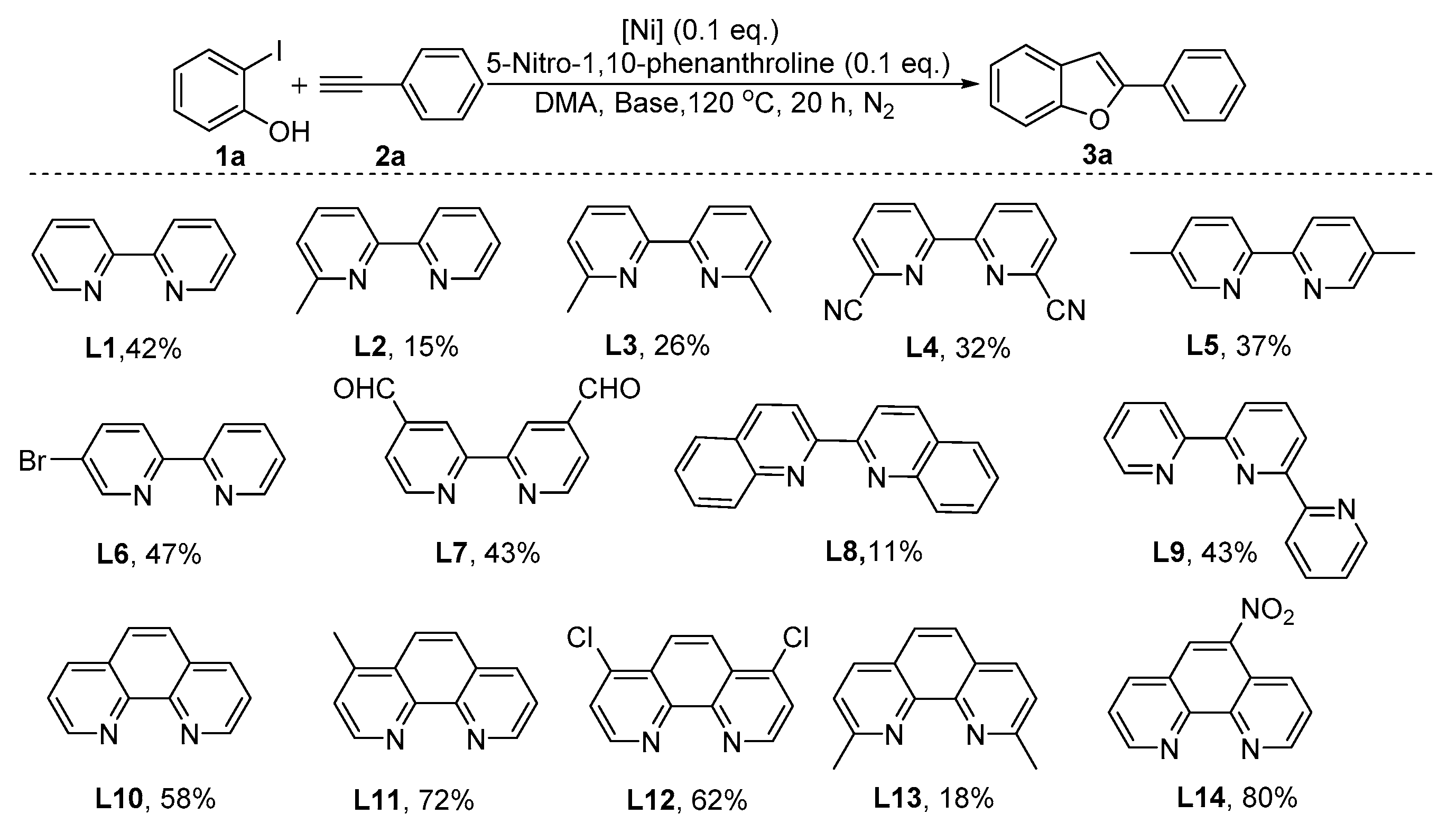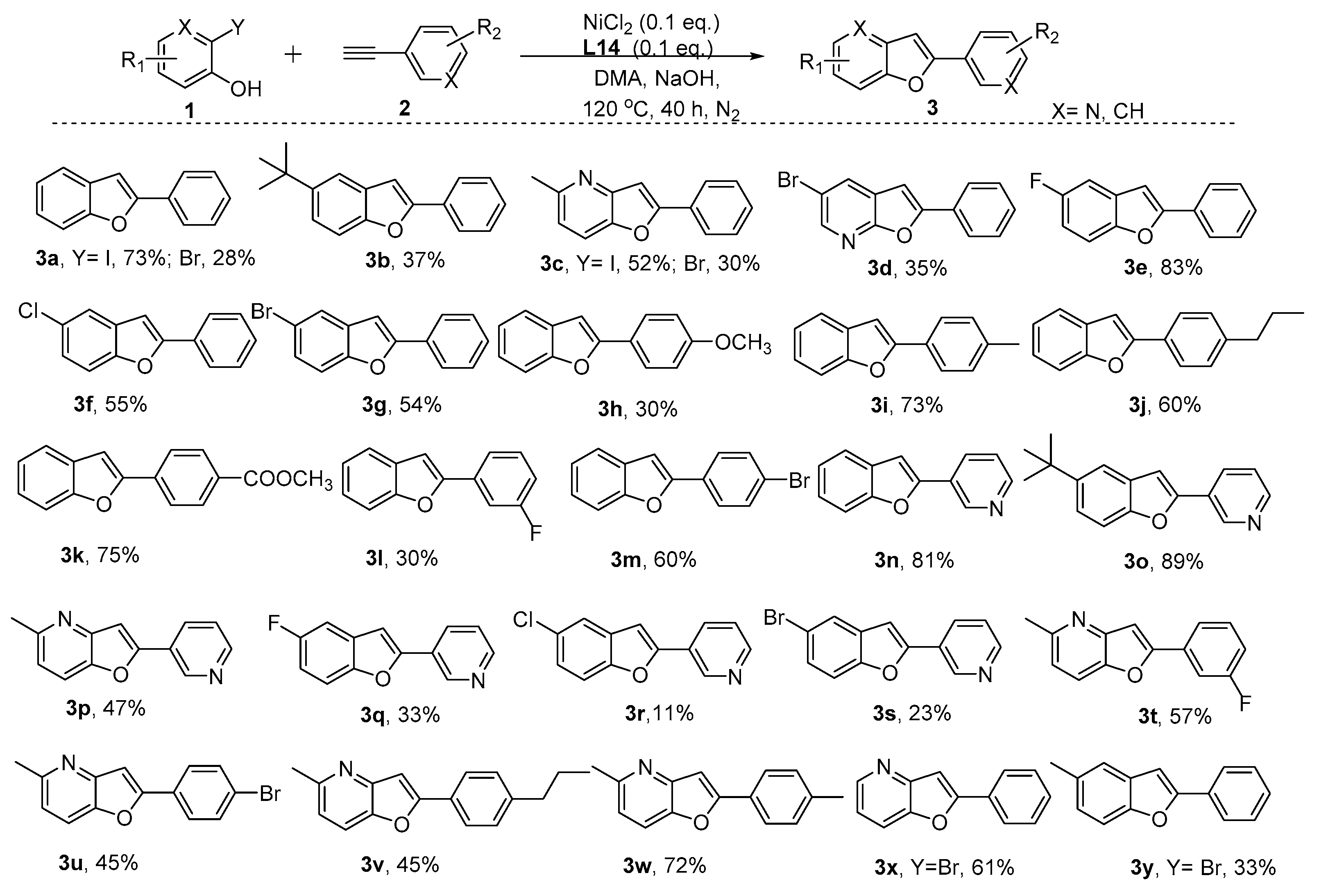Synthesis of 2-Substituted Benzo[b]furans/furo-Pyridines Catalyzed by NiCl2
Abstract
1. Introduction
2. Results and Discussion
3. Materials and Methods
4. Conclusions
Supplementary Materials
Author Contributions
Funding
Conflicts of Interest
References
- Heravi, M.M.; Zadsirjan, V. Recent Advances in the Synthesis of Benzo[b]furans. Adv. Heterocycl. Chem. 2015, 117, 261–376. [Google Scholar]
- Kwiecień, H.; Smist, M.; Kowalewska, M. Recent Development on the Synthesis of Benzo[b]- and Naphtho[b]furans: A Review. Curr. Org. Synth. 2012, 9, 529–560. [Google Scholar] [CrossRef]
- Jian, J.; Fan, J.; Yang, H.; Lan, P.; Li, M.; Liu, P.; Gao, H.; Sun, P. Total Synthesis of the Flavonoid Natural Product Houttuynoid A. J. Nat. Prod. 2018, 81, 371–377. [Google Scholar] [CrossRef] [PubMed]
- Zhihai, K.; Ying-Yeung, Y.; Gavin Chit, T.; Xiao-Shui, P. Progress in Heterocyclic Chemistry; Elsevier Ltd.: Amstertan, The Netherlands, 2015; pp. 203–246. [Google Scholar]
- Patricia, M.P.; Angela, R.A.; Maria, C.M.Y.; Astréa, M.G.; Vanderlanda, S.B. Nor-Lignans from the leaves of Styrax ferrugineus (Styracaceae) with antibacterial and antifungal activity. Phytochemistry 2000, 55, 597–601. [Google Scholar]
- Chen, P.C.; Tsai, W.J.; Ueng, Y.F.; Tzeng, T.T.; Chen, H.L.; Zhu, P.R.; Huang, C.H.; Shiao, Y.J.; Li, W.T. Neuroprotective and Antineuroinflammatory Effects of Hydroxyl-Functionalized Stilbenes and 2-Arylbenzo[b]furans. J. Med. Chem. 2017, 60, 4062–4073. [Google Scholar] [CrossRef] [PubMed]
- York, S.; Makoto, T.; Kazuhiko, S.; Yoshiaki, N.; John, H.F. Anti-Markovnikov Hydroheteroarylation of Unactivated Alkenes with Indoles, Pyrroles, Benzofurans, and Furans Catalyzed by a Nickel-N-Heterocyclic Carbene System. J. Am. Chem. Soc. 2015, 137, 12215–12218. [Google Scholar]
- Jiang, P.; Guo, M.; Fu, L.; Wen, Y.; Shen, X.; Zhou, L. [(PhCH2O)2P(CH3)2CHNCH(CH3)2]2PdCl2/CuI as Cocatalyst for Coupling-Cyclization of 2-Iodophenol with Terminal Alkynes in Water. Catalysts 2018, 8, 136. [Google Scholar] [CrossRef]
- Arcadi, A.; Cacchi, S.; Marinelli, F. Palladium-Catalyzed Reaction of 2-Hydroxyaryl and Hydroxyheteroaryl Halides with 1-Alkynes: An Improved Route to the Benzo[b]furan Ring System. Synthesis 1986, 9, 749–751. [Google Scholar] [CrossRef]
- Thanh, T.; Milad, M.; Ky, K.A.L.; Olafs, D. General Method for Functionalized Polyaryl Synthesis via Aryne Intermediates. J. Am. Chem. Soc. 2014, 136, 8568–8576. [Google Scholar]
- Zhou, R.; Wang, W.; Jiang, Z.J.; Wang, K.; Zheng, X.L.; Fu, H.Y.; Chen, H.; Li, R.X. One-pot synthesis of 2-substituted benzo[b]furans via Pd–tetraphosphine catalyzed coupling of 2-halophenols with alkynes. Chem. Commun. 2014, 50, 6023–6026. [Google Scholar] [CrossRef] [PubMed]
- Zbigniew, R. NHC-Catalyzed Organocatalytic Asymmetric Approach to 2,2-Disubstituted Benzofuran-3(2H)-ones Containing Fully Substituted Quaternary Stereogenic Center. Catalysts 2019, 9, 192. [Google Scholar] [CrossRef]
- Alexandre, B.; Karl, G.P.J.; Ning, Y.; Cheuk-Wai, T.; Ingmar, P.; Xiaodong, Z.; JanE, B. Synthesis of Benzofurans and Indoles from Terminal Alkynes and Iodoaromatics Catalyzed by Recyclable Palladium Nanoparticles Immobilized on Siliceous Mesocellular Foam. Chem. Eur. J. 2017, 23, 12886–12891. [Google Scholar]
- Chandan, S.; Prakasham, A.P.; Manoj Kumar, G.; Raymond, B.J.; Prasenjit, G. One-Pot Tandem Hiyama Alkynylation/Cyclizations by Palladium(II) Acyclic Diaminocarbene (ADC) Complexes Yielding Biologically Relevant Benzofuran Scaffolds. ACS Omega 2018, 3, 1740–1756. [Google Scholar]
- Abir, S.; Pragati, P.; Wahidur Rahaman, S.M.; Kuldeep, S.; Akshi, T.; Pierre, D.H.; Jitendra, B.K. A Triflamide-Tethered N-Heterocyclic Carbene-Rhodium(I) Catalyst for Hydroalkoxylation Reactions: Ligand-Promoted Nucleophilic Activation of Alcohols. ChemCatChem 2017, 9, 1397–1401. [Google Scholar]
- Shohei, O.; Kohei, T.; Hiromichi, F.; Mitsuhiro, A. Cycloisomerization between Aryl Enol Ether and Silylalkynes under Ruthenium Hydride Catalysis: Synthesis of 2,3-Disubstituted Benzofurans. Org. Lett. 2017, 19, 2422–2425. [Google Scholar]
- Chen, Z.P.; Zhou, Y.; Shui, M.Z.; Liu, F. CuI Catalyzed Domino Coupling-Cyclization of 2-iodo-phenols and 1-alkynes to the Synthesis of 2-substituted Benzo[b]furans/furo-pyridines. Tetrahedron Lett. 2019, 60, 133–136. [Google Scholar] [CrossRef]
- Lin, C.Y.; Power, P.P. Complexes of Ni(I): A “rare” Oxidation State of Growing Importance. Chem. Soc. Rev. 2017, 46, 5347–5399. [Google Scholar] [CrossRef] [PubMed]
- Michael, N. Sustainable Catalysis: With Non-endangered Metals, Part 1; The Royal Society of Chemistry: Cambrige, UK, 2016; pp. 407–468. [Google Scholar]
- Zimmerman, P.; Limberg, C. Activation of Small Molecules at Nickel(I) Moieties. J. Am. Chem. Soc. 2017, 139, 4233–4242. [Google Scholar] [CrossRef] [PubMed]
- Wang, L.; Li, P.; Zhang, Y. The Sonogashira Coupling Reaction Catalyzed by Ultrafine Nickel(0) Powder. Chem. Commun. 2004, 35, 514–515. [Google Scholar] [CrossRef] [PubMed]




| Entry | [Ni] | Base | Solvent | Yield/% |
|---|---|---|---|---|
| 1 | NiCl2 | NaOH | DMA | 80 |
| 2 | NiCl2 | NaOH | DMA | 47 2 |
| 3 | - | NaOH | DMA | 0.8 |
| 4 | Ni(dppe)Cl2 | NaOH | DMA | 26 |
| 5 | Ni(dppp)Cl2 | NaOH | DMA | 16 |
| 6 | Ni(PPh3)2Cl2 | NaOH | DMA | 41 |
| 7 | Ni(PCy3)2Cl2 | NaOH | DMA | 13 |
| 8 | Ni(COD)2Cl2 | NaOH | DMA | 28 |
| 9 | NiSO4 | NaOH | DMA | 75 |
| 10 | NiCl2 | NaHCO3 | DMA | 0.6 |
| 11 | NiCl2 | KHCO3 | DMA | 0.7 |
| 12 | NiCl2 | Na2CO3 | DMA | 2 |
| 13 | NiCl2 | Cs2CO3 | DMA | 1 |
| 14 | NiCl2 | K3PO4 | DMA | 26 |
| 15 | NiCl2 | KOH | DMA | 74 |
| 16 | NiCl2 | Et3N | DMA | 0.1 |
| 17 | NiCl2 | pyridine | DMA | 0.1 |
| 18 | NiCl2 | NaOH | DMF | 56 |
| 19 | NiCl2 | NaOH | 1,4-Dioxane | 0.2 3 |
| 20 | NiCl2 | NaOH | Toluene | 0.6 3 |
| 21 | NiCl2 | NaOH | H2O | - 3 |
| 22 | NiCl2 | NaOH | n-BuOH | 0.1 3 |
| 23 | NiCl2 | NaOH | t-BuOH | - 4 |
© 2019 by the authors. Licensee MDPI, Basel, Switzerland. This article is an open access article distributed under the terms and conditions of the Creative Commons Attribution (CC BY) license (http://creativecommons.org/licenses/by/4.0/).
Share and Cite
Zhou, R.; Ding, Y.; Yang, M. Synthesis of 2-Substituted Benzo[b]furans/furo-Pyridines Catalyzed by NiCl2. Catalysts 2019, 9, 1019. https://doi.org/10.3390/catal9121019
Zhou R, Ding Y, Yang M. Synthesis of 2-Substituted Benzo[b]furans/furo-Pyridines Catalyzed by NiCl2. Catalysts. 2019; 9(12):1019. https://doi.org/10.3390/catal9121019
Chicago/Turabian StyleZhou, Rong, Yanli Ding, and Mili Yang. 2019. "Synthesis of 2-Substituted Benzo[b]furans/furo-Pyridines Catalyzed by NiCl2" Catalysts 9, no. 12: 1019. https://doi.org/10.3390/catal9121019
APA StyleZhou, R., Ding, Y., & Yang, M. (2019). Synthesis of 2-Substituted Benzo[b]furans/furo-Pyridines Catalyzed by NiCl2. Catalysts, 9(12), 1019. https://doi.org/10.3390/catal9121019




